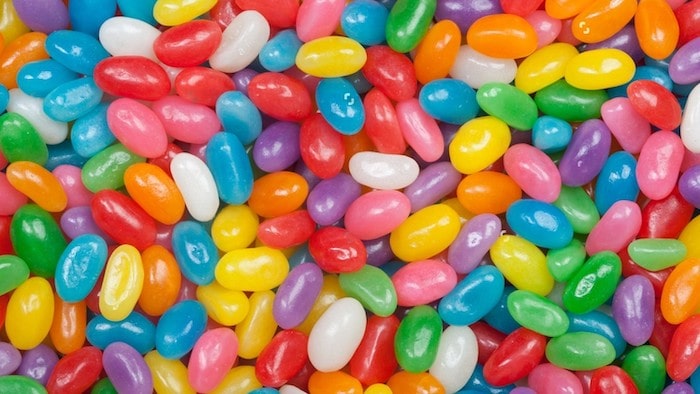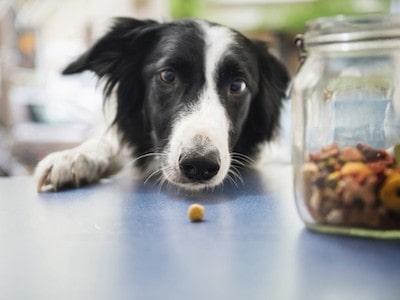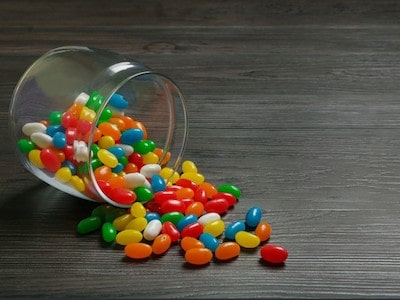As pet owners, we all want to express our love and affection for our furry friends by giving them the occasional treat. It is essential, though, to remember that not all foods that are safe for us are also safe for pets. Jelly beans are one of these as they can cause serious health issues if consumed in large amounts by dogs.

This article seeks to answer the critical question: ‘How many jelly beans can kill a dog?’ It will also explore the factors that influence this number, as well as symptoms of jelly bean poisoning and what you should do if your dog has consumed too many.
By the end of this article, you’ll have acquired a better knowledge on how to keep your canine companion safe from foods that can harm them and the importance of informing other pet owners about these risks. We will also give you a list of other hazardous foods for dogs with their respective danger levels. Let’s begin!
Can Dogs Eat Jelly Beans
Although jelly beans are not toxic to dogs in small amounts, they should still not be eaten due to their high sugar content and the presence of artificial sweeteners such as xylitol, which can cause gastrointestinal upset, diarrhea, and even pancreatitis if ingested in large quantities.

Not only do jelly beans contain artificial colors and flavors that can potentially cause allergic reactions in some dogs, but they may also have caffeine which, when ingested in large quantities, can be toxic to them.
To avoid any potential harm to your pup, it is best to keep jelly beans and other sugary treats away from them. In the event that they do accidentally consume a few jelly beans, likely no serious repercussions will occur. Yet if they eat an excessive amount of candy or display any signs of distress, you should contact your veterinarian right away.
Why Jelly Beans Are Dangerous to Dogs
Dogs can be put in danger by jelly beans for several reasons. Primarily, they contain high levels of sugar and artificial sweeteners like xylitol, which can cause toxicity if taken in a large quantity.
Xylitol induces a sudden release of insulin resulting in hypoglycemia (low blood sugar) and potential liver damage. Even small amounts of xylitol are risky to dogs; hence, it is essential to keep all products containing this ingredient away from them.

Jelly beans, besides having sugar and artificial sweeteners, contain artificial colors and flavors which may lead to allergic reactions in some dogs. These could range from mild itching or irritation up to more severe signs like hives, swelling and difficulty breathing.
Dogs can suffer from restlessness, rapid breathing, heart palpitations, muscle tremors and even seizures when exposed to large quantities of caffeine which may be present in some types of jelly beans.
Dogs, particularly smaller breeds, should be kept away from jelly beans as they are a choking hazard. If swallowed whole or chewed on, the bean can become lodged in their throat and lead to serious breathing difficulties.
How Many Jelly Beans Can Kill A Dog?
The number of jelly beans that can be fatal to a dog depends on several factors, including the size and weight of the dog, the type and amount of jelly beans ingested, and the dog’s overall health. However, as a general rule, it’s best to keep all jelly beans away from dogs as they are not a safe treat option.
Containing high levels of sugar and artificial sweeteners like xylitol, jelly beans can lead to hypoglycemia (low blood sugar) and even liver failure in dogs if ingested in large amounts. Xylitol is especially hazardous for dogs; ingestion of even a tiny amount can be fatal.
In addition to sugar and artificial sweeteners, some jelly beans may contain caffeine. Caffeine toxicity in dogs can be dangerous if ingested in large amounts as it can cause symptoms such as restlessness, rapid breathing, heart palpitations, muscle tremors, and seizures.
If you think your dog has eaten too many jelly beans or anything else dangerous, it is vital to get in touch with your vet right away. They can tell you the best way to proceed, which may involve inducing vomiting, giving activated charcoal or providing supportive treatments like IV fluids and keeping an eye on them.
For the safety of your dog, it’s best to stay away from jelly beans or any other sugary snacks and opt for healthier treats that are specially formulated for dogs and won’t endanger their health.
Symptoms of Jelly Bean Poisoning in Dogs
Symptoms of jelly bean poisoning in dogs can vary depending on the type and amount of jelly beans ingested and the size and overall health of the dog. However, some common signs of jelly bean poisoning in dogs include:

- Vomiting and diarrhea: Dogs can experience gastrointestinal upset, vomiting and diarrhea when consuming jelly beans that are high in sugar and artificial sweeteners.
- Loss of appetite: Dogs who have ingested jelly beans may experience a loss of appetite and become disinclined to eat or drink.
- Lethargy: Dogs may become lethargic or appear weak and unsteady on their feet.
- Hyperactivity or restlessness: Some dogs may display signs of hyperactivity or restlessness, particularly if they have ingested jelly beans with caffeine.
- Tremors or seizures: In severe cases, jelly bean poisoning can cause tremors or seizures in dogs.
- Jaundice: Xylitol in jelly beans can cause liver failure and jaundice, a yellowing of the eyes and skin.
Other Harmful Foods for Dogs
In addition to jelly beans, there are several other foods that are harmful to dogs and can cause health problems if ingested. Some common examples include:
- Chocolate: Theobromine, a substance present in chocolate, can be toxic to dogs and cause such symptoms as vomiting, diarrhea, tremors, seizures and even death.
- Grapes and raisins: Dogs can suffer from kidney failure due to ingestion of grapes and raisins, resulting in dehydration, vomiting, and lethargy.
- Onions and garlic: Compounds present in onions and garlic can cause anemia, weakness, and breathing problems in dogs by damaging their red blood cells.
- Avocado: Avocado contains persin, which can cause vomiting, diarrhea, and pancreatitis in dogs.
- Alcohol: Even small amounts of alcohol can be toxic to dogs and can cause vomiting, diarrhea, difficulty breathing, tremors, and even coma or death.
- Macadamia nuts: Macadamia nuts can cause lethargy, vomiting, hyperthermia, and tremors in dogs.
- Xylitol: Xylitol is a sugar substitute that can be found in many sugar-free products, including gum, candy, and baked goods. Xylitol can cause hypoglycemia (low blood sugar) and liver failure in dogs.
FAQs
If your dog has ingested a small amount of jelly beans, they are unlikely to suffer serious harm. However, if they ingest a large amount of jelly beans or show any signs of distress, you should contact your veterinarian immediately. Your veterinarian can advise you on the best course of action, which may include inducing vomiting, administering activated charcoal, or providing supportive care such as IV fluids and monitoring.
While some human foods are safe for dogs in moderation, it’s important to choose treats that are specifically designed for dogs and to avoid giving them foods that are high in fat, salt, sugar, or other harmful ingredients. If you have any concerns about your dog’s diet or nutritional needs, consult with your veterinarian.
The best way to keep your dog safe from harmful foods is to keep all human foods out of their reach and to choose safe and healthy treat options specifically designed for dogs. Additionally, it’s important to supervise your dog closely and to teach them the “leave it” command to discourage them from eating anything they shouldn’t. If you have any concerns about your dog’s diet or nutritional needs, consult with your veterinarian.
No, it’s best to keep all jelly beans away from dogs as they are not a safe treat option. Jelly beans contain high levels of sugar and artificial sweeteners such as xylitol, which can cause hypoglycemia and even liver failure in dogs if ingested in large quantities. Some jelly beans may also contain caffeine, which can be toxic to dogs if ingested in large amounts.
Conclusion
In conclusion, while jelly beans may seem like a harmless treat for dogs, they can actually be dangerous if ingested in large quantities. Jelly beans contain high levels of sugar and artificial sweeteners such as xylitol, which can cause hypoglycemia and even liver failure in dogs, as well as artificial colors and flavors that can cause allergic reactions.
To keep your dog safe, it’s best to avoid giving them jelly beans or any other sugary treats. Instead, opt for healthy and safe treat options specifically designed for dogs, such as dental chews, rawhide bones, and natural treats like carrots and apples. It’s also important to keep all harmful foods out of your dog’s reach and to supervise them closely to prevent accidental ingestion.
If you suspect that your dog has ingested a harmful substance or is exhibiting any unusual symptoms, contact your veterinarian immediately. They can advise you on the best course of action and provide the necessary care and treatment to keep your furry friend safe and healthy. By taking these precautions, you can help ensure that your dog stays happy, healthy, and free from harm.

Ellis is a retired veterinary technician and full-time contributor at DogLovesBest. He likes writing about pet health care tips and reviews the products that are useful for fidos on a daily basis.
Ellis also guardians a Siberian husky, Nova, and a cat named Shilly. They all live happily with his wife Ammy, and both the dogs on a seaside apartment in Queens, NY.
